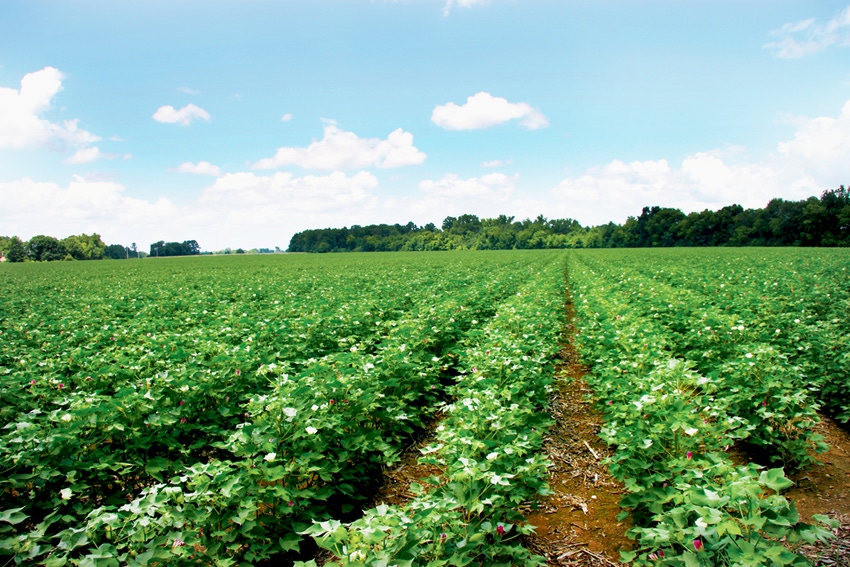
As much of Mississippi’s cotton crop is beginning to grow out of its rocky start due to a wet, cold spring, Darrin Dodds says new technologies on the horizon will offer additional management tools for growers, beginning in 2016.

DARRIN DODDS
But some will come with stringent use requirements, he said at the annual joint meeting of the Mississippi Boll Weevil Management Corporation and the Mississippi Farm Bureau Federation Cotton Policy Committee.
One of the new products, XtendFlex cotton, which is tolerant to dicamba herbicide from Monsanto, is being grown on limited acreages this year, says Dodds, who is Mississippi State University Extension/Research professor of plant and soil science.
“We aren’t allowed to apply dicamba to XtendFlex cotton this year,” he notes, “but it’s my understanding we’re still on track to be able to apply dicamba over the top next year.”
In situations with aggressive pigweed control, Dodds says, “we’re finding that some of the combinations we’re applying on XtendFlex cotton are damaging it a bit more than we’d like to see.
“We’re learning some lessons about this technology now that it has been released commercially. With some of the injury we saw early on 2-, 3-, and 4-leaf cotton, it looks like the plants are growing out of it pretty well. My concern is that crop growth was already delayed because of weather and wet feet, and I hate to see anything hold us up more.
Stay current on what’s happening in Mid-South agriculture: Subscribe to Delta Farm Press Daily.
“We have some graduate students looking at a number of tank mix combinations of various herbicides to try and determine which are more and which are less injurious, so we can give you some recommendations on what works best with the XtendFlex technology.”
The plan, Dodds says, is to pair some of the combinations with insecticides for thrips control. “The goal is to reduce trips across the field. We don’t want to be spraying a herbicide today and a thrips insecticide tomorrow, so we’re trying to work out combinations for you to do it all in one application.”
Enlist, a Dow product, will allow growers to apply 2,4-D over cotton and/or soybeans, Dodds notes. “It’s my understanding that they’re ready to go with soybeans, but they’re still working to see who their partners are going to be in terms of genetics.
Trait being deregulated
“The Enlist trait itself is in the process of being deregulated in cotton by USDA, and I think they’re planning on having it completely deregulated sometime this year.”
Deltapine, Dyna-Gro, and NexGen are aligned with the XTendFlex technology, he says, and PhytoGen with Enlist.

In years past, says Darrin Dodds, cotton began blooming 52-54 days after planting, but this year blooming is about 10 days later.
“We don’t know yet about Bayer; they haven’t divulged their intentions. There is some concern that no matter who they go with, the process of putting traits into varieties doesn’t happen overnight. It still takes time to develop quality varieties and test their performance.”
But, Dodds says, there will be challenges when these products are released to market. “Dicamba and 2,4-D cotton don’t intermix, which means off-target movement and sprayer hygiene are going to be extremely important.
“It’s difficult enough to thoroughly clean out a sprayer now. A lot of work is being done on tank contamination and cleanout. Several MSU faculty are working on developing training modules for these technologies in cooperation with the Mississippi Department of Agriculture and Commerce. These training modules will be required for those who choose to purchase these technologies and apply dicamba or 2,4-D.
“There will also be very specific requirements —particularly for dicamba — as to the spray tips that can be used. It’s my understanding that if you’re going to put dicamba over the top of dicamba cotton next year, you can only use TTI 04 spray tips.”
Looking back at last year’s crop, Dodds says Mississippi cotton growers “are due a pat on the back — for the second year in a row, they set a new yield record: 1,232 lbs. state average for dryland and irrigated. That’s something to be proud of.
“USDA yield records show we’ve averaged 950 lbs. or above for nine of the last 12 years, and the last two years we’ve topped 1,200 pounds. In only one year of that period was there a hiccup, in 2009 when a wet fall cut yields to 600-700 lbs.”
A difficult planting season

Paul Tedford, left, Lyon, Miss., and Randy Crowe, Oxford, Miss., were among those attending the annual joint meeting of the Mississippi Boll Weevil Management Corporation and the Mississippi Farm Bureau Federation Cotton Policy Committee.
As with the previous two years, he says, 2015 brought a difficult spring for growers. “Some cotton was planted in late April, but the bulk of the planting started after the first part of May, and we still had some cotton being planted as late as June 6-10.
“Once conditions started to dry up, we went from too wet to much too dry in a week or 10 days. We actually had some growers waiting to try and get some rain so they could finish planting, and then it started raining again, with some areas of northeast Mississippi getting from 8 to 12 inches over just a couple of days. Water has probably been the biggest issue thus far this season. I think wet feet has hindered the crop more than anything.”
Once cotton was in the ground, Dodds says, “it didn’t seem to want to grow — it just seemed to sit there. A lot of that was probably due to wet feet and not growing off early. It didn’t really seem to want to turn the corner, but now I think it’s finally getting there.
“The last three or four years, I’ve been seeing cotton bloom 52 to 54 days after planting. This year, I wasn’t seeing blooms until 62 to 64 days after planting. The first bloom I heard of was about mid-June near Sidon. In the same field, they picked 1,700-1,800 pounds last year.
“It seems we’re about 10 days behind normal. It has been fairly cool thus far, and we’ve not had a tremendous amount of heat units. But we’re starting to see more blooms now (July 8).”
Dodds noted that USDA’s last report projected cotton acres in Mississippi at 350,000, “but the number I’m hearing now is 310,000. If we hadn’t had all the rain mid- to late May that pushed more acres into soybeans, I think we’d have been closer to USDA’s 350,00.
About the Author(s)
You May Also Like




